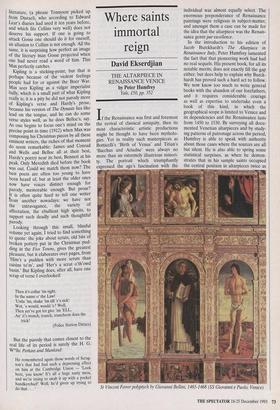Where saints immortal reign
David Ekserdjian
THE ALTARPIECE IN RENAISSANCE VENICE by Peter Humfrey Yale, f50, pp. 352 If the Renaissance was first and foremost the revival of classical antiquity, then its most characteristic artistic productions might be thought to have been mytholo- gies. Yet in reality such masterpieces as Botticelli's 'Birth of Venus' and Titian's `Bacchus and Ariadne' were always no more than an extremely illustrious minori- ty. The portrait which triumphantly expressed the age's fascination with the individual was almost equally select. The enormous preponderance of Renaissance paintings were religious in subject-matter, and amongst them a case can be made for the idea that the altarpiece was the Renais- sance genre par excellence.
In the introduction to his edition of Jacob Burckhardt's The Altarpiece in Renaissance Italy, Peter Humfrey lamented the fact that that pioneering work had had no real sequels. His present book, for all its notable merits, does not exactly fill the gap either, but does help to explain why Burck- hardt has proved such a hard act to follow. We now know too much to write general books with the abandon of our forefathers, and it requires considerable courage as well as expertise to undertake even a book of this kind, in which the geographical scope is limited to Venice and its dependencies and the Renaissance lasts from 1450 to 1530. By surveying all docu- mented Venetian altarpieces and by study- ing patterns of patronage across the period, Humfrey is able to speak with authority about those cases where the sources are all but silent. He is also able to spring some statistical surprises, as when he demon- strates that in his sample saints occupied the central position in altarpieces twice as St Vincent Ferrer polyptych by Giovanni Bellini, 1465-1468 (SS Giovanni e Paolo, Venice) often as the Virgin and Child.
The book is divided into two halves, one concerned with questions of history and theology and their importance for works of art, the other devoted to an inevitably more straightforward treatment of the stylistic and iconographic evolution of the altarpiece in the period. This proceeds from the polyptychs of the various mem- bers of the Vivarini family, through the vital contributions of Giovanni Bellini and Antonello da Messina, before concluding with an extremely illuminating and deliber- ately backward-looking consideration of the young Titian and his achievement. A chapter is also given over to the generally neglected topic of the sculptured altar- piece.
As stated, Humfrey has sensibly decided to concentrate on Venice, which he takes to include not only its mainland provinces but also the destinations of export ware, which reached Bari in the south as well as the former Yugoslavia. However, it is this insistent focus that creates the book's major weakness. It would have been fasci- nating to see some attempt to compare developments in Florence, or to speculate about why the predella never caught on in Venice. It will be argued that such side- ways glances are beyond the scope of this book, but it remains unclear where else we can hope to find them.
What is entirely admirable, on the other hand, is the way in which Humfrey man- ages to marshal a general argument and to combine it with a spectacular grasp of detail. This means that he guides us down the Grand Canal, but does not neglect the minor callette either, while the illustrations include all the old favourites, as well as numerous oddities, whose eccentricities are in the main plausibly explained. Unlike some scholars I can think of, the author inspires confidence, which means that one never feels that information liable to sabo- tage his thesis is being nefariously sup- pressed. The only omission I really regret is a trivial one: no place is found for Antonio da Negroponte's extraordinary Madonna and Child in San Francesco della Vigna. This quirkily beautiful picture, which dates from the heyday of Vivarinesque late goth- ic in Venice, but has an addition by a later hand in the style of Giovanni Bellini, con- forms to none of the norms so flexibly defined by Humfrey. It is a genuine one-off, not least since no other paintings by the artist are known. Maybe one day Dr Humfrey will write an article on this lost sheep, and tell us what he thinks of it.











































































































 Previous page
Previous page